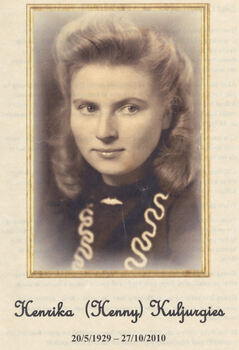Historical information
Henrika (Henny) Kuljurgies was born in Lithuania on 20th May 1929 and came to Australia in 1948 on the USAT General Stewart, the third transport carrying displaced people from the Baltic countries. Like many thousands of migrants she spent a short time at Bonegilla Migrant Reception Centre.
.
Henrika was raised by Margarita Vrubliauskiene who was her aunt although always referred to as her mother. Her family was torn apart by World War II and the invasion of her homeland. Under new immigration policies implemented by Arthur Caldwell, Australia offered a home to refugees from the Baltic States.
It was initially easier to be accepted into Australia as a single person as you could be placed more easily for work. On 30 October 1947, Margarita Vrubliauskiene departed on the first transport to arrive in Australia, the USAT General Stuart Heintzelman. Henrika who was 18 years old at that time, remained in Germany until her passage could also be arranged.
Also aboard this first transport was a young man Alfredas Kuljurgies who Henrika was to later marry.
After a short time at Bonegilla, Henrika was transferred to Mulwala House in Canberra where Margarita had already been relocated. Mulwala House provided accommodation for the growing number of public servants in Canberra and Margarita was working there as a house maid.
Whilst at Bonegilla Henrika had met Alfredas Kuljurgies and although she was not initially attracted to Alfred his persistence in courting her finally paid off. They married in Canberra on 14th September 1948. They had two sons, Fred and Charlie and settled into a new life at Little River (Killara). As well as acquiring some land in the area, Alfred established his business, Bandiana Motors in 1950. Alfred and Henrika were both granted Australian Citizenship on 28th June 1956.
As her sons grew older, Henrika (Henny) became more involved in her passion of painting. She painted landscapes which captured the area around her new home. Henrika became affectionately know as the “bird Lady” as her paintings always included a magpie. Her work is held in many galleries, homes and public buildings including the hospital where she passed away on 27th October 2010.
In 2018 a small park in Killara not far from her former home, studio Bandiana Motors, was named in her honour.
Significance
These items are significant because they help to document the story of a Lithuanian migrant in Wodonga.
Physical description
A collection of black and white images and articles about Henrika Kuljurgies, her mother Margarita and husband Alfred.








